Keywords
Hookah; Waterpipe; Instagram; Social media; Risk perception
Introduction
Waterpipe smoking, which is also known as hookah, narghile, or shisha smoking, is a method of smoking that involves passing tobacco through a waterpipe prior to inhalation [1,2]. Recently, studies have confirmed a sharp increase in rates of Waterpipe Smoking (WPS) in the United States and other Western countries [3-9], especially among young adults [4,10] who are at risk for becoming lifelong smokers. Despite the fact that WPS has high levels of nicotine absorption [11,12], few waterpipe smokers are aware of the long-term health risks [13] associated with the activity. For example, in a study among adult U.S. waterpipe users, the majority of respondents indicated that WPS was not only less harmful, but also less addictive than cigarette smoking [14,15], which is a false belief. At the same time that rates of WPS have increased, social media platforms such as Instagram have become a popular way to portray content related to waterpipe smoking. Thus, public health researchers have become interested in the potential relationship between the portrayal of waterpipe smoking on social media and the willingness of users to try the activity.
Instagram, which reached 700 million users in 2017 [16], is the second most popular social media platform in the U.S, making it an important avenue to share content related to waterpipe smoking. Indeed, 53% of users are between the ages of 18 and 29, which is an age range at high risk for smoking adoption and addiction [17]. However, to the authors’ knowledge, to date no academic studies have been conducted that examine the portrayal of waterpipe smoking on the visual social media platform Instagram. Thus, in this study, we aim to answer the follow research questions:
RQ1: How is waterpipe smoking portrayed and represented on Instagram?
RQ2: How do users respond to the waterpipe-related posts they encounter on Instagram?
RQ3: How are user attitudes and subjective norms related to waterpipe smoking expressed on Instagram?
In this study, we aim to apply The Theory of Reasoned Action (TRA) to examine the portrayal of waterpipe smoking on Instagram. The TRA posits that behavioral intent is influenced by two main factors: attitude (i.e. beliefs about the consequences of a certain type of behavior) and subjective norms (i.e. the perceived expectations/opinions of influential peers). Indeed, studies have shown a strong relationship between attitudes and subjective norms and the use of waterpipe smoking [18-20]. In similar studies, researchers have used the terms “pleasant/unpleasant”, “good/bad”, “fun/not fun”, or “healthy/not healthy” to measure users’ attitudes, and the concept of how someone thinks people who are important to them will feel about waterpipe smoking to measure subjective norms [7].
Although no research presently exists which examines the portrayal of waterpipe smoking on Instagram, a study found that 92% of waterpipe-related YouTube videos are positive (pro-waterpipe) in nature [21]. Thus, the following hypothesis is proposed:
H1: Instagram posts that are focused on waterpipe smoking are more likely to portray the activity in a positive than in a negative light.
Methods
Sample
The present study examined content related to waterpipe tobacco smoking on Instagram, a popular social media platform where users share photos and videos. In a quantitative content analysis, 1,000 Instagram posts were randomly selected from a larger sample of Instagram posts using #waterpipe and/ or #hookah in March and April of 2015. The sample size was based on current best practices in social media content analysis research [22,23]. The data were obtained from Instagram using the publically available application programming interface (API). For this study, an access token was acquired and the API method of tags/search was applied to query all Instagram posts with # waterpipe and # hookah. Software was written in the Python programming language to download the JSON formatted query results, which were subsequently stored in the SQLite database. To simplify the analysis, the fields of interest were exported from SQLite into a CSV file using the Pandas library (from Python) and then the statistics of interest were computed.
Coding instrument
Coding protocols for posts related to the topic of waterpipe smoking by Instagram users were developed, tested, and implemented for the coding process. For each pin, coders recorded the following: the timeframe of the post; the Instagram user’s handle (i.e., the username or digital identity); and the number of likes and comments. In addition to these characteristics, the posts were coded for the type of Instagram medium, the tonality of the post, and the presence and frequency of hashtags, mentions, and hyperlinks. Finally, each post was coded on the two main constructs in the Theory of Reasoned Action (TRA): attitudes and subjective norms.
The type of medium was classified into two categories: photo or video. Post tonality was categorized as pro-waterpipe smoking (positive), anti-waterpipe smoking (negative), or neutral (not approving or disapproving of waterpipe smoking). All posts were coded for emotional appeal (pleasure/relaxation, fun, anxiety/ concern, other, or none). “Pleasure” was operationalized as a feeling of enjoyment and relief of tension [22], and “fun” was operationalized as containing terms of fun and celebration. Furthermore, “anxiety” was operationalized as facing a concrete danger, and fear/concern was operationalized as facing an uncertain and existential threat [23]. The posts were also coded for risk representation (nicotine intake, carbon monoxide poisoning, secondhand smoke exposure, initialization of cigarette smoking, danger of addiction, other, and none), type of venue (public/commercial, private, and unknown), as well as type of poster (individual or commercial/organization). Finally, all photos and captions were coded for the presence of two of the main TRA constructs: attitude (i.e., beliefs related to the act of waterpipe smoking) and subjective norms (i.e. the perceived expectations/ opinions of influential peers) [7].
Intercoder reliability
Two coders were trained to establish intercoder reliability. The first coder coded all of the posts (N=1,000), while the second coder coded 10% of the posts (n=100) for the subjective study variables. After pre-testing and subsequent revisions of the coding protocol, intercoder reliability was assessed with the Recall statistical program using Scott’s Pi (24), which was 0.92 on average. The coefficients were all considered to be reliable. Analysis was conducted with Statistical Package for the Social Sciences (SPSS), version 22.
Results
RQ1: How is waterpipe smoking portrayed and represented on Instagram?
Type of medium: Findings show that 89.5% (n=895) of Instagram posts consist of a photo, while 10.5% (n=105) of Instagram posts consist of a video (Table 1).
| Variables |
n (%) |
| Type of medium |
Photo
Video |
895 (89.5)
105 (10.5) |
| Links to external websites |
Yes
No |
999 (99.99)
1 (0.001) |
| Venue |
Commercial
Private
Undetermined |
495 (49.5)
138 (13.8)
367 (36.7) |
| Emotional appeal |
Sense of pleasure/relaxation
Sense of fun
Not contain emotional appeal |
931 (93.1)
24 (2.4)
45 (4.5) |
| Risk representation |
Yes
No |
0 (0)
1000 (100) |
| Hashtags |
Yes
No |
959 (95.9)
41 (4.1) |
| Mentions |
Yes
No |
217 (21.7)
783 (78.3) |
Table 1: How is waterpipe smoking portrayed and represented on Instagram (n=1000).
Links to external websites: Only one of the 1,000 posts in the sample contained a hyperlink to another website, while 99.9% (n=999) of the posts did not contain a hyperlink to another website.
Venue: Of the 1,000 posts, 49.5% (n=495) included a photo that was taken in a commercial establishment, such as a waterpipe bar, restaurant, or hotel; or a public space such as a beach or park, while 13.8% (n=138) included a photo that was taken in a private residence. We were unable to determine if the photos in the remaining posts [36.7% (n=367)] were taken in a public or a private location.
Type of poster: Of all the Instagram posts in this sample, 56.6% (n=566) were posted by individual accounts, while 43.4% (n=434) were published by commercial accounts.
Emotional appeal: Most posts appealed to a sense of pleasure and relaxation (93.1%, n=931) based on the primary emotion in the overall image conveyed to the coders. The remaining images appealed to a sense of fun (2.4%, n=24) or did not contain emotional appeal (4.5%, n=45). No fear, anxiety, or other negative emotions were detected. Examples for pleasure/ relaxation-focused posts can be found in Figures 1 and 2.
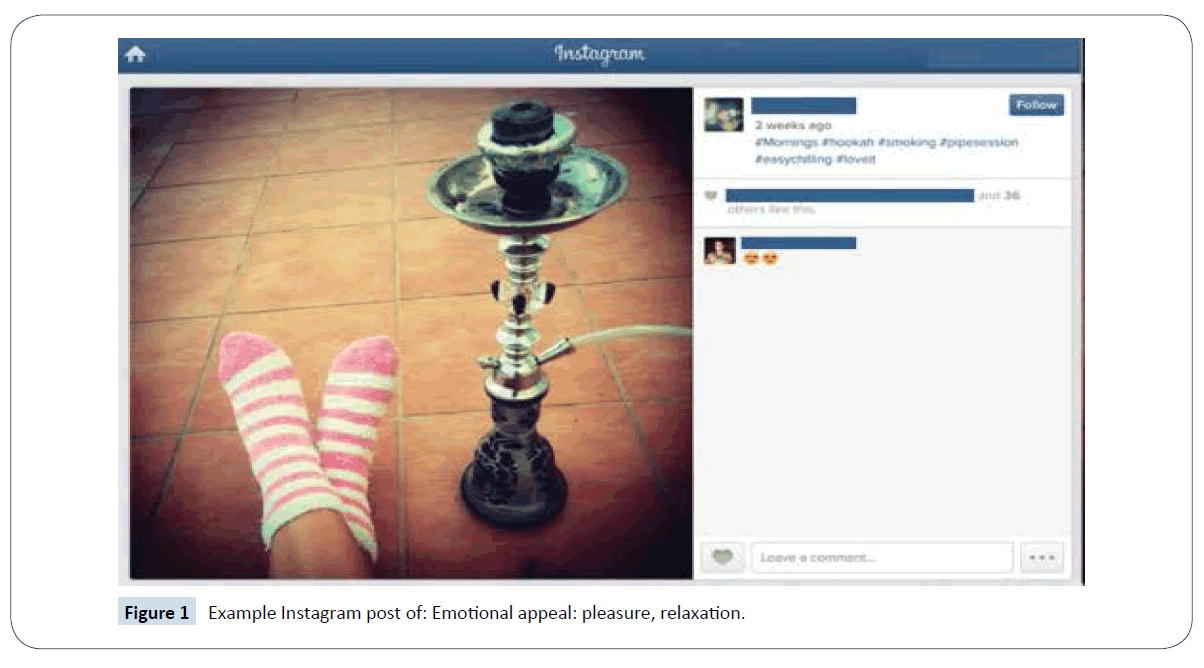
Figure 1: Example Instagram post of: Emotional appeal: pleasure, relaxation.
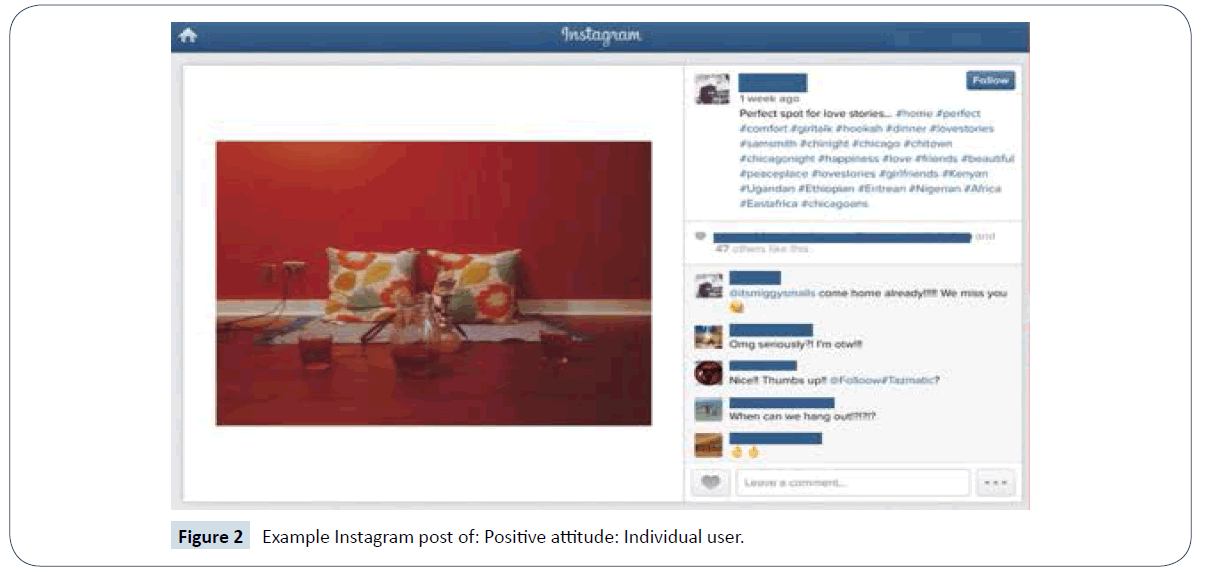
Figure 2: Example Instagram post of: Positive attitude: Individual user.
Risk representation: None of the posts (n=0) discussed the health risks related to waterpipe smoking.
Hashtags and mentions: The majority of the posts [95.9% (n=959)] contained at least one hashtag, and the range for the number of hashtags in posts was 43. The mean number of hashtags for the entire sample was 10.60 (SD=9.157), and the median (a better measure of central tendency because Instagram metrics are not normally distributed) was 7.00. Approximately one fifth of posts [21.7% (n=217)] contained at least one mention (a "mention" is an Instagram user name), while 78.3% (n=783) mentions. The range for the number of mentions was 11. The mean number of mentions was 0.50 (SD=1.312).
Mann-Whitney U tests were run to determine if there were differences in hashtag frequencies between posts based on the type of Instagram account. Distributions of the hashtag frequencies were similar based on visual inspection. Hashtag frequencies were statistically significantly different between posts originating with a commercial account (Mdn=10.00) and posts originating with an individual account (Mdn=6.00), U=94, 421.500, z=-6.282, p<0.001). In other words, posts by commercial entities contained significantly more hashtags than posts by individual users.
An independent sample t-test revealed that the identity of the poster was also accompanied by significant differences in terms of the frequency of mentions used [commercial (M=0.9, SD=1.74) vs. individual (M=0.2, SD=0.75)] with t (554.990)=7.031, p<0.001]. Therefore, posts by commercial entities utilized significantly more mentions than posts by individual users.
RQ2: How do Instagram users respond to the waterpipe posts they encounter on Instagram?
Instagram allows users to interact by “liking” and adding comments to posts. In this study, all posts were liked at least once, and 60.6% (n=606) of posts received at least one comment. The mean number of likes was 38.15 (SD=65.875), and the mean number of comments was 2.20 (SD=6.654). However, social media engagement variables, including Instagram, are not normally distributed, and the median is a more appropriate measure of central tendency. The median for the number of likes was 22.00, and the median number of comments was 1.00. The range for the number of likes was 1,133, and the range for the number of comments was 172. Mann-Whitney U tests were run to determine if there were differences in like and comment frequencies between posts based on the type of Instagram account. Distributions of the like and comment frequencies were similar based on visual inspection. Like frequencies were statistically significantly different between posts originating with a commercial account (Mdn=24.00) and posts originating with an individual account (Mdn=22.00), U=109,986.000, z=- 2.836, p=005. There were no significant differences in comment frequencies between posts based on the type of account. Thus, it was clear that Instagram posts by commercial entities were liked significantly more frequently than Instagram posts by individuals were liked.
RQ3: How were attitudes and subjective norms related to waterpipe smoking represented in Instagram posts?
Users’ attitudes towards waterpipe smoking were positive, and WPS was portrayed as good, fun, or healthy in 94.9% (n=949) of the posts. In contrast, subjective norms, which were measured as expressed approval of waterpipe smoking by those close to the poster, did not appear often in the sample: 13.0% (n=130) mentioned approval, while 0.2% (n=2) mentioned disapproval, and 86.8 (n=868) of the Instagram posts did not display either approval or disapproval.
Chi-square tests showed that the percentage of posts which mentioned waterpipe smoking as “good” (attitude) differed by Instagram poster identity. For example, individual posters expressed more positive attitude toward waterpipe smoking than commercial users: X2 (1)=3.965, p=0.046 (Figure 3). In addition, Chi-square tests also revealed that the percentage of posts which mentioned the approval of waterpipe smoking by other users (subjective norms) differed by Instagram poster identity. For example, individual posters expressed more positive subjective norms toward waterpipe smoking than commercial users expressed: X2 (1)=21.660, p<0.001.
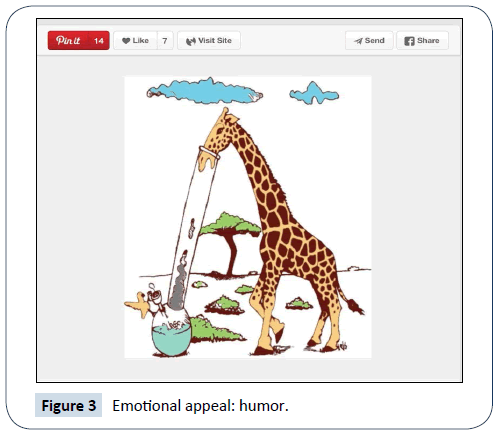
Figure 3: Emotional appeal: humor.
H1: Waterpipe focused Instagram posts are more likely to portray waterpipe smoking in a positive light than in a negative light
Post tonality: Tonality was consistently positive toward WPS; indeed, 96.6% (n=966) of posts were pro-waterpipe smoking, and only one post displayed anti-waterpipe smoking sentiment. The remaining 3.3% (n=33) of posts were neutral in tone. Thus, findings support our hypothesis that Instagram posts focused on WPS were more likely to portray waterpipe smoking in a positive light than in a negative light.
Discussion and Conclusion
Findings showed that the majority of waterpipe-related Instagram posts portrayed waterpipe smoking in a positive light. This result was similar to findings on other social media platforms: Pinterest [25], Twitter [26,27], and Tumblr [28]. In this way, the portrayal of WPS on Instagram resembles the portrayal of smoking in the movies before the general surgeon launched a nationwide anti-smoking campaign [29]. Indeed, social media may be the new, powerful medium for smoking advertisement, which may lead to increased rates of WPS use in adolescents [30]. Considering the potential of social media to both attract audiences and spread information quickly, the presence of waterpipe-focused posts on Instagram cannot be ignored by researchers in the area of public health. Also, Instagram may be used promote smoking cessation program. One study on Facebook found that one out of three young adults expressed their interest in using Facebook to quit smoking [31].
In addition to the positive portrayal of WPS on Instagram, results indicate that Instagram is becoming a popular advertising platform for WPS. For example, in our study, we found that 56.6% of the images were posted by individual and, commerical sources, while 43.4% were posted by businesses or organizations. In a similar study conducted on Pinterest, 5.6%, and 22.1% of images were posted by individual, commercial, respectively, while 72.3% could not be categorized as [25]. In addition, results demonstrated that commercial users’ posts received more likes than individual users’ posts. This is concerning because these commercial posts are basically advertisements that promote waterpipe use without any mention of potential risks or negative effects. Since studies have shown there is a significant positive relationship between cigarette smoking and smoking initiation as well as smoking continuation [32], waterpipe advertisements may affect waterpipe smoking initiation and/or continuation.
Waterpipe smoking is a social event. it often occurs in group settings at home or in “waterpipe/hookah bars”. Arab American smokers view smoking waterpipe as a chance to socialize with friends and family members [33] and this is becoming the case with other population and age groups as well. Strong social addiction for WPS has been established in previous studies, and may contribute to the poor quitting rate among waterpipe smokers [34]. Findings from the current study reflect this phenomenon: out of the 1,000 photos in this sample, 49.5% appeared to be taken in a commercial place such as a waterpipe bar, while only 13.8% appeared to be located in private residences (in 36.7% of the posts, the type of location was not easily determined). Posts were also analyzed according to the emotional appeal represented in the posts; 93.1% appeared to have a sense of pleasure/relaxation, while 2.4% displayed a sense of fun–both are emotions usually congruent with outgoing and socialization events. A similar finding was reported on Pinterest, where most of the images appealed to a sense of pleasure, relaxation, beauty, and aesthetic (Figure 4) [25].
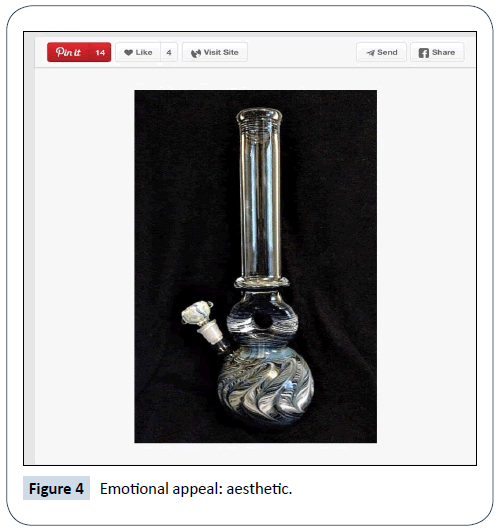
Figure 4: Emotional appeal: aesthetic.
A common misconception about waterpipe smoking is that it is a safer and healthier alternative to other tobacco products [35]. This misconception was reflected in the current study: None of the waterpipe-themed Instagram posts included any information on the documented health risks of waterpipe smoking (Figure 5). In addition, 96.6% of the 1,000 posts analyzed in the study were pro-waterpipe smoking, 3.3% were neutral in tone, and only 0.1% of the posts were anti-waterpipe smoking. Guidry et al. reported in their study on Pinterest that 98.9% (791 out of 800) of the images did not address the health risks of waterpipe smoking [25]. These findings are consistent with the findings in the available literature demonstrating that waterpipe smoking is perceived as less of a health and addiction risk than regular cigarette smoking [10,36].
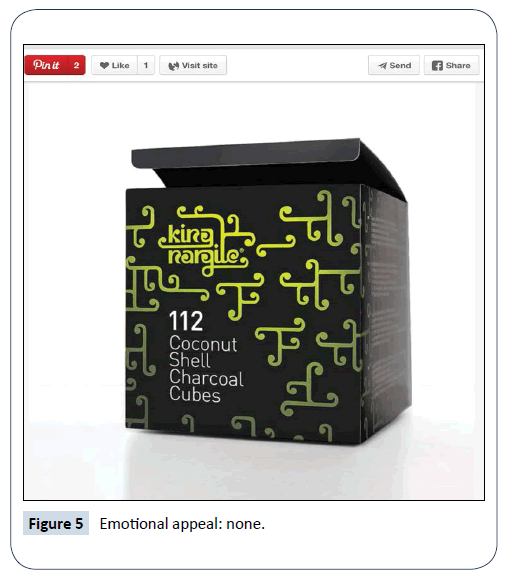
Figure 5: Emotional appeal: none.
When considering the Theory of Reasoned Action (TRA) constructs, more than 90% of the posts mention a positive attitude toward waterpipe smoking–waterpipe smoking is fun, good or healthy. A majority of the posts reflect a sense of satisfaction with the experience of waterpipe smoking. Subjective norm–the concept that people important to oneself will approve of waterpipe smoking–was mentioned less frequently, but was still present in more than 20% of the Instagram posts. These TRA constructs can successfully modify intentions to use the waterpipe if the direction of the construct changes. The fact that individual users mention TRA constructs more frequently than commercial users provides hope that individual waterpipe users may be open to conversations based on attitudes and subjective norms.
Finally, to date, public health practitioners have not used Instagram to disseminate factual information to users about the risks of waterpipe smoking. Conversations about waterpipe smoking are taking place on social media-listening to these conversations and participating as well as providing leadership in them is an important step in educating the growing population of waterpipe users about the health risks of this practice.
Acknowledgments
The authors would like to acknowledge Debra McDonald for her editorial support.
References
- Grekin ER, Ayna D (2008) Argileh use among college students in the United States: an emerging trend. J Stud Alcohol Drugs 69: 472-475.
- Knishkowy B, Amitai Y (2005) Water-pipe (narghile) smoking: an emerging health risk behavior. Pediatrics 116: e113-e9.
- Alzyoud S, Haddad L, El Shahawy O, Ghadban R, Kheirallah K, et al. (2014) Patterns of waterpipe use among Arab immigrants in the USA: a pilot study. Br J Med Mesd Res 4: 816-827.
- Eissenberg T, Ward KD, Smith-Simone S, Maziak W (2008) Waterpipe tobacco smoking on a U.S college campus: prevalence and correlates. J Adolesc Health 42: 526-529.
- Jackson D, Aveyard P (2008) Waterpipe smoking in students: prevalence, risk factors, symptoms of addiction, and smoke intake. evidence from one British university. BMC Public Health 8: 174-178.
- Primack B, Sidani J, Agarwal A, Shadel W, Donny E, et al. (2008) Prevalence of and associations with waterpipe tobacco smoking among U.S university students. Ann Behav Med 36: 81-86.
- Martinasek MP, McDermott R, Bryant C (2013) Antecedents of university students' hookah smoking intention. Am J Health Behav 37: 599-609.
- Martinasek MP, Haddad LG, Wheldon CW, Barnett TE (2017) Beliefs and attitudes associated with hookah smoking among a United States College Population. Respir Care 62: 370-379.
- Majeed BA, Sterling KL, Weaver SR, Pechacek TF, Eriksen MP (2017) Prevalence and harm perceptions of hookah smoking among US adults, 2014–2015. Addict Behav 69: 78-86.
- Cobb C, Ward KD, Maziak W, Shihadeh AL, Eissenberg T (2010) Waterpipe tobacco smoking: an emerging health crisis in the United States. Am J Health Behav 34: 275-285.
- Neergaard J, Singh P, Job J, Montgomery S (2007) Waterpipe smoking and nicotine exposure: a review of the current evidence. Nicotine Tob Res 9: 987-994.
- Haddad L, Kelly DL, Weglicki LS, Barnett TE, Ferrell AV, et al. (2016) A systematic review of effects of waterpipe smoking on cardiovascular and respiratory health outcomes. Tob Use Insights 9: 13.
- Eissenberg T, Shihadeh A (2009) Waterpipe tobacco and cigarette smoking: direct comparison of toxicant exposure. Am J Prev Med 37: 518-523.
- Ward KD, Eissenberg T, Gray JN, Srinivas V, Wilson N, et al. (2007) Characteristics of U.S. waterpipe users: a preliminary report. Nicotine Tob Res 9: 1339-1346.
- Grinberg A, Goodwin RD (2016) Prevalence and correlates of hookah use: a nationally representative sample of US adults ages 18–40 years old. Am J Drug Alcohol Abuse 42: 567-576.
- https://www.pewinternet.org/2015/01/09/social-media-update-2014/
- Freedman KS (2012) Smoking initiation among young adults in the United States and Canada, 1998-2010: a systematic review. Prev Chronic Dis 9: e05.
- Martinasek MP, McDermott RJ, Martini L (2011) Waterpipe (hookah) tobacco smoking among youth. Curr Probl Pediatr Adolesc Health Care 41: 34-57.
- Noonan D, Kulbok P, Yan G (2011) Intention to smoke tobacco using a waterpipe among students in a Southeastern U.S college. Public Health Nurs 28: 494-502.
- Smith SY (2006) Nicotine products harm perception and psychosocial correlates of use in college freshmen. Baltimore, MD: Johns Hopkins University.
- Carroll MV, Shensa A, Primack BA (2013) A comparison of cigarette and hookah related videos on YouTube. Tob Control 22: 319-323.
- Aaker JL, Lee AY (2001) "I" seek pleasures and "we" avoid pains: the role of self-regulatory goals in information processing and persuasion. J Cons Res 28: 33-49.
- Jin Y, Pang A, Cameron GT (2012) Toward a publics-driven, emotion-based conceptualization in crisis communication: unearthing dominant emotions in multi-staged testing of the integrated crisis mapping (ICM) model. J Publ Relat Res 24: 266-298.
- Scott WA (1955) Reliability of content analysis: The case of nominal scale coding. Public Opin Q 19: 321-325.
- Guidry J, Jin Y, Haddad L, Zhang Y, Smith J (2016) How health risks are pinpointed (or not) on social media: the portrayal of waterpipe smoking on Pinterest. Health Commun 31: 659-667.
- Grant A, O'Mahoney H (2016) Portrayal of waterpipe (shisha, hookah, nargile) smoking on Twitter: a qualitative exploration. Public Health 140: 128-135.
- Krauss MJ (2015) Hookah-related Twitter chatter: a content analysis. Prev Chronic Dis 12.
- Primack BA, Carroll MV, Shensa A, Davis W, Levine MD (2016) Sex differences in hookah-related images posted on tumblr: a content analysis. J Health Commun 21: 366-375.
- Charlesworth A, Glantz SA (2005) Smoking in the movies increases adolescent smoking: a review. Pediatrics 116: 1516-1528.
- Sargent JD, Beach ML, Adachi-Mejia AM, Gibson JJ, Titus-Ernstoff LT, et al. (2005) Exposure to movie smoking: its relation to smoking initiation among US adolescents. Pediatrics 116: 1183-1191.
- Ramo DE, Liu H, Prochaska JJ (2015) A mixed-methods study of young adults' receptivity to using Facebook for smoking cessation: if you build it, will they come? Am J Health Promot 29: e126-e35.
- Capella ML, Webster C, Kinard BR (2011) A review of the effect of cigarette advertising. Int J Res Mark 28: 269-279.
- Haddad L, El-Shahawy O, Shishani K, Madanat H, Alzyoud S (2012) Cigarette use attitudes and effects of acculturation among Arab immigrants in USA: A preliminary study.
- Paul CL, Ross S, Bryant J, Hill W, Bonevski B, et al. (2010) The social context of smoking: a qualitative study comparing smokers of high versus low socioeconomic position. BMC Public Health 10: 211.
- Asfar T, Ward KD, Eissenberg T, Maziak W (2005) Comparison of patterns of use, beliefs, and attitudes related to waterpipe between beginning and established smokers. BMC Public Health 5: 19-29.
- Griffiths MA, Ford EW (2014) Hookah smoking: behaviors and beliefs among young consumers in the United States. Soc Work Public Health 29: 17-26.







